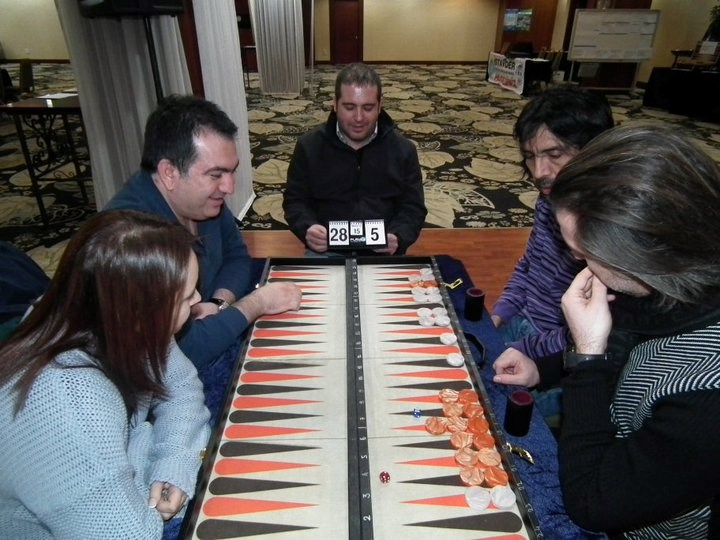Some games wear the label ‘classic’ easily.
Backgammon is most certainly one of those, with its origins dating back thousands of years.
For those unfamiliar with Backgammon each player has a set of 15 pieces which must be moved from their starting positions, around, and then off the board.
Dice are thrown each turn, and each player must decide which of his men to move based on the outcome of the roll.
Players can capture each other’s men, forcing the captured men to restart their journey around the board.
The winner is the first player to get all 15 men off the board.
The game is an ancient one. It “may be the first game to be mentioned in written history, going back 5,000 years to the Sumerians of ancient Mesopotamia. During the 1920’s, archaeologists unearthed five boards from a cemetery in the ancient town of Ur. At another location, pieces and dice were also found along with the board. Boards from ancient Egypt have also been recovered from the tomb of Tutankhamun, including a mechanical dice box, no doubt intended to stop cheaters,” notes the boardgamegeek.com listing for the game.
The game remains well-followed today, supported by the World Backgammon Association ( )
Thanks to email I caught up with Wayne Joseph an active player as well as active within the organization that supports backgammon globally.
Of course my first question was about how Joseph fell in love with backgammon?
“The amazing thing about backgammon is, whoever invented this ancient game, deliberately built-in a finely-tuned ‘Game Balance’,” he said. “Many games are decided by a close race, or a hugely decisive roll. One might be on the edge of defeat, and yet come back from the brink on the last roll to seize a dramatic victory.
“The enduring popularity of backgammon is partially due to its relatively easy learning-curve, its portability, and the genuine excitement it can create.
“I was lucky enough to be living in Oman for one year; an expat school teacher taught me to play as a way for us to pass the long quiet nights.
“I became intrigued by the game and I installed the free GNU Backgammon program to practice against.
“When I returned to the UK I set up the local Sussex Backgammon League which I’ve been running for the past four years now. It is wonderful to see how total beginners have developed over time and are now able to play at an advanced level.”
But, there are thousands of games out there, and only a handful have national and international organizations, so why backgammon?
The WBGF () evolved from the EUBGF (under Steen Gr√∏nbech); our new President is Bernhard Mayr, said Joseph.
“Our long-term goals are to unify the occasional differences in regional rulesets, support emerging nations and raise participation in backgammon, as well as nurture younger players to become tomorrow’s experts,” he offered.
And there is a competitive side too.
“Putting on huge events like the World Team Championships where players from all over the world get together and socialize as well as compete are growing bigger each year,” said Joseph. “This positive demand and reception gives the WBGF and our partner organisations even more encouragement to improve.”
Online play certainly plays into popularity, in particular recently in the face of a worldwide pandemic.
“The social face-to-face aspect of backgammon has always been a main drawing card for the sport,” said Joseph. “The coronavirus has unfortunately impacted upon many organizations plans to deliver ‘Live’ tournaments during this spring and summer of 2020.
“However, thanks to the wonders of the internet, we have seen that a huge amount of people still partake.”
Online platforms such as¬Ý , , and are amongst those which are providing free gaming.
“They have proved to be so popular during the lockdown that on a few rare occasions the servers have become overloaded,” said Joseph. “I don’t have any figures, but I have a feeling that even more people are playing formal backgammon matches than normal.”
Joseph said in general interest in backgammon appears on the upswing.
“Aside from the coronavirus I believe that player numbers are increasing,” he said. “We have initiatives in place for the first Online Backgammon Youth World Championship () which will take place in July this year.
“This will help get the next generation of players involved.
“We are also forming a new partnership with the Mind Sports Olympiad which is usually an annual physical event in London. It will be held online this year, so everybody around the world can take part without having to fly!”
Looking specifically at Canada, the Canadian Backgammon Federation (CBF) has members and clubs in Vancouver, Calgary, Winnipeg, Toronto, Montreal and throughout the Maritime Provinces. Club Officials publish a quarterly newsletter and provide training to members and administer both live and online competitions. The Canadian Backgammon Federation can be contacted through their website at
So ultimately what does Joseph see as the thing to draw people to the game?
“Backgammon is a unique game - a finely balanced mixture of luck and skill,” he said. “I find it to be an enjoyable and even slightly academic pursuit which requires skill of evaluating risk, reward, probability and statistics.
“Balancing maths with one’s instincts and gut feelings is an interesting challenge.
“On the surface it is a simple game that takes an hour to learn, but it has many layers so takes a lifetime to master.
“Many backgammon games can be downloaded and played for free on smartphones - I would recommend downloading and playing XG Mobile for a few games and then when you are confident enough, perhaps joining one of the previously mentioned online sites for some proper matches. “Backgammon players are usually a very friendly bunch and everybody remembers they were a beginner at one time.”




